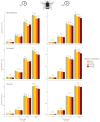Ozone Pollution Alters Olfaction and Behavior of Pollinators
- PMID: 33919364
- PMCID: PMC8143334
- DOI: 10.3390/antiox10050636
Ozone Pollution Alters Olfaction and Behavior of Pollinators
Abstract
Concentration of air pollutants, particularly ozone (O3), has dramatically increased since pre-industrial times in the troposphere. Due to the strong oxidative potential of O3, negative effects on both emission and lifetime in the atmosphere of plant volatile organic compounds (VOCs) have already been highlighted. VOCs alteration by O3 may potentially affect the attraction of pollinators that rely on these chemical signals. Surprisingly, direct effects of O3 on the olfaction and the behavioral response of pollinators have not been investigated so far. We developed a comprehensive experiment under controlled conditions to assess O3 physiological and behavioral effects on two pollinator species, differing in their ecological traits. Using several realistic concentrations of O3 and various exposure times, we investigated the odor antennal detection and the attraction to VOCs present in the floral scents of their associated plants. Our results showed, in both species, a clear effect of exposure to high O3 concentrations on the ability to detect and react to the floral VOCs. These effects depend on the VOC tested and its concentration, and the O3 exposure (concentration and duration) on the pollinator species. Pollination systems may, therefore, be impaired in different ways by increased levels of O3, the effects of which will likely depend on whether the exposure is chronic or, as in this study, punctual, likely causing some pollination systems to be more vulnerable than others. While several studies have already shown the negative impact of O3 on VOCs emission and lifetime in the atmosphere, this study reveals, for the first time, that this impact alters the pollinator detection and behavior. These findings highlight the urgent need to consider air pollution when evaluating threats to pollinators.
Keywords: atmospheric pollution; behavioral response; ozone; plant VOC perception; plant-pollinator interactions; pollinators.
Conflict of interest statement
The authors declare no conflict of interest. The funders had no role in the design of the study, in the collection, analyses, or interpretation of data, in the writing of the manuscript, or in the decision to publish the results.
Figures





Similar articles
-
Acute ozone exposure impairs detection of floral odor, learning, and memory of honey bees, through olfactory generalization.Sci Total Environ. 2022 Jun 25;827:154342. doi: 10.1016/j.scitotenv.2022.154342. Epub 2022 Mar 5. Sci Total Environ. 2022. PMID: 35257776
-
Ozone alters the chemical signal required for plant - insect pollination: The case of the Mediterranean fig tree and its specific pollinator.Sci Total Environ. 2024 Apr 1;919:170861. doi: 10.1016/j.scitotenv.2024.170861. Epub 2024 Feb 12. Sci Total Environ. 2024. PMID: 38354792
-
Ozone exposure induces metabolic stress and olfactory memory disturbance in honey bees.Chemosphere. 2024 Jan;346:140647. doi: 10.1016/j.chemosphere.2023.140647. Epub 2023 Nov 8. Chemosphere. 2024. PMID: 37949186
-
Plant volatile organic compounds (VOCs) in ozone (O3) polluted atmospheres: the ecological effects.J Chem Ecol. 2010 Jan;36(1):22-34. doi: 10.1007/s10886-009-9732-3. J Chem Ecol. 2010. PMID: 20084432 Review.
-
[Effects of Elevated Ozone on Biogenic Volatile Organic Compounds (BVOCs) Emission: A Review].Huan Jing Ke Xue. 2018 Nov 8;39(11):5257-5265. doi: 10.13227/j.hjkx.201802075. Huan Jing Ke Xue. 2018. PMID: 30628251 Review. Chinese.
Cited by
-
Volatile Emission of Pear Tree (Pyrus communis) and Olfactory Perception of Pear Psyllids (Cacopsylla pyri and C. pyrisuga) are Affected by Elevated Tropospheric Ozone Concentration.J Chem Ecol. 2025 Aug 27;51(5):86. doi: 10.1007/s10886-025-01642-x. J Chem Ecol. 2025. PMID: 40864332 Free PMC article.
-
Becoming nose-blind-Climate change impacts on chemical communication.Glob Chang Biol. 2022 Aug;28(15):4495-4505. doi: 10.1111/gcb.16209. Epub 2022 May 16. Glob Chang Biol. 2022. PMID: 35574993 Free PMC article.
-
Applying Artificial Neural Networks to Oxidative Stress Biomarkers in Forager Honey Bees (Apis mellifera) for Ecological Assessment.Toxics. 2023 Aug 1;11(8):661. doi: 10.3390/toxics11080661. Toxics. 2023. PMID: 37624166 Free PMC article.
-
Non-linear associations between meteorological factors, ambient air pollutants and major mosquito-borne diseases in Thailand.PLoS Negl Trop Dis. 2023 Dec 27;17(12):e0011763. doi: 10.1371/journal.pntd.0011763. eCollection 2023 Dec. PLoS Negl Trop Dis. 2023. PMID: 38150471 Free PMC article.
-
Ozone Induces Distress Behaviors in Fig Wasps with a Reduced Chance of Recovery.Insects. 2021 Nov 5;12(11):995. doi: 10.3390/insects12110995. Insects. 2021. PMID: 34821795 Free PMC article.
References
-
- Parmesan C. Ecological and evolutionary responses to recent climate change. Annu. Rev. Ecol. Evol. Syst. 2006;37:637–669. doi: 10.1146/annurev.ecolsys.37.091305.110100. - DOI
-
- Gallai N., Salles J.-M., Settele J., Vaissière B. Economic valuation of the vulnerability of world agriculture confronted to pollinator decline. Ecol. Econ. 2009;68:810–821. doi: 10.1016/j.ecolecon.2008.06.014. - DOI
Grants and funding
LinkOut - more resources
Full Text Sources
Other Literature Sources

